2023届高考英语二轮复习课件:专题一 名词和冠词(共50张PPT)
文档属性
| 名称 | 2023届高考英语二轮复习课件:专题一 名词和冠词(共50张PPT) |  | |
| 格式 | pptx | ||
| 文件大小 | 3.1MB | ||
| 资源类型 | 教案 | ||
| 版本资源 | 通用版 | ||
| 科目 | 英语 | ||
| 更新时间 | 2022-11-04 15:01:28 | ||
图片预览



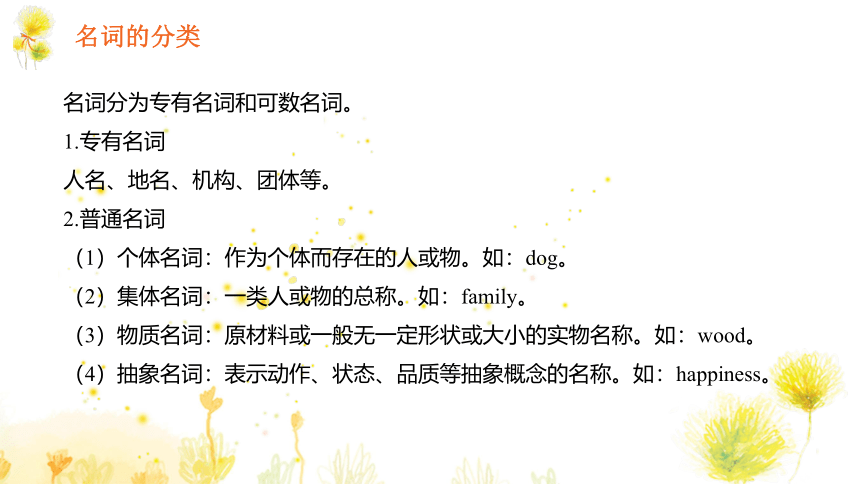
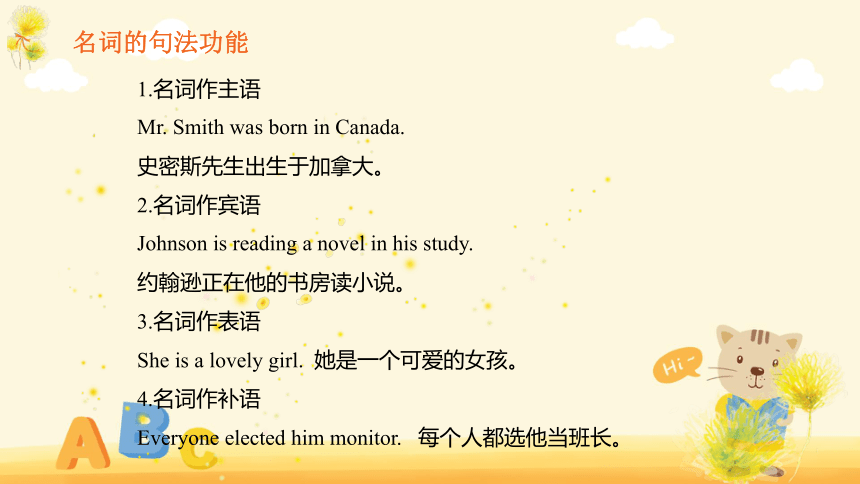

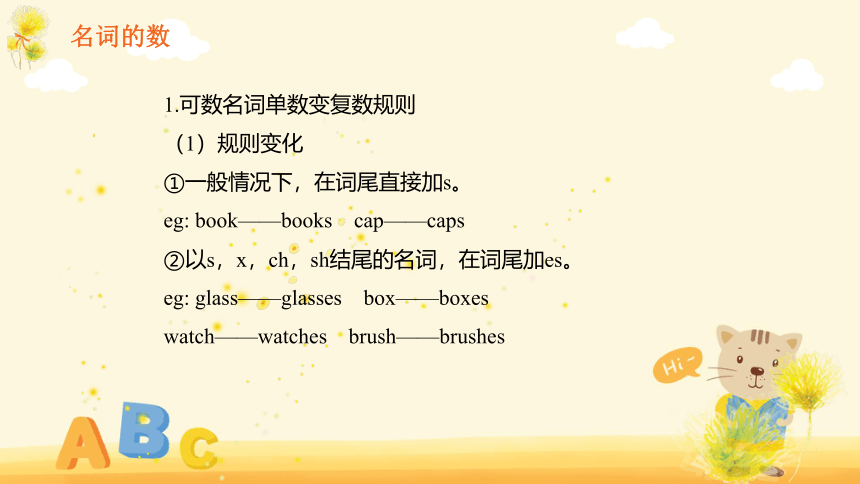
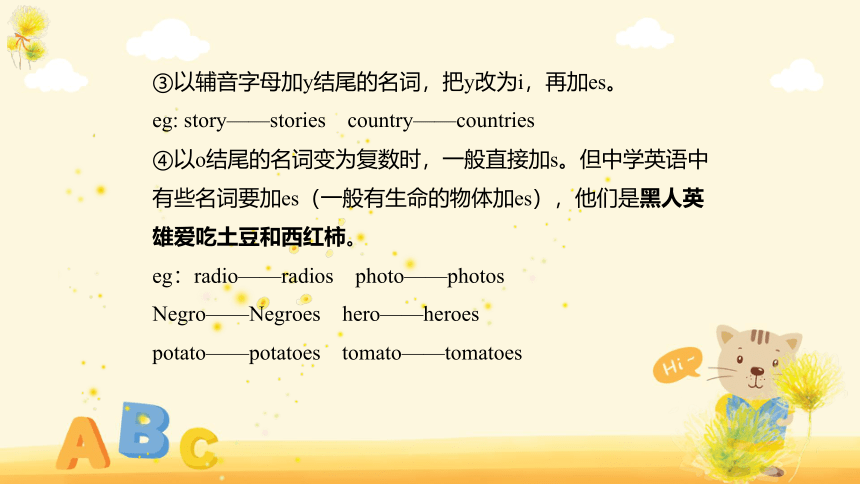

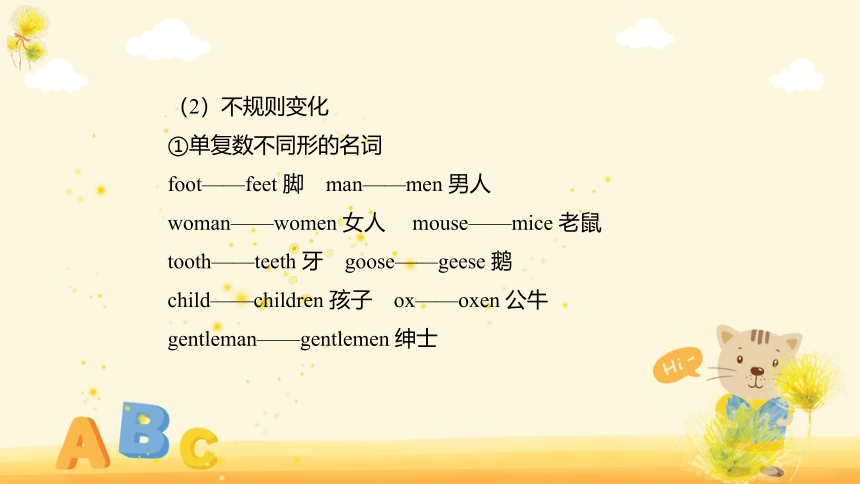
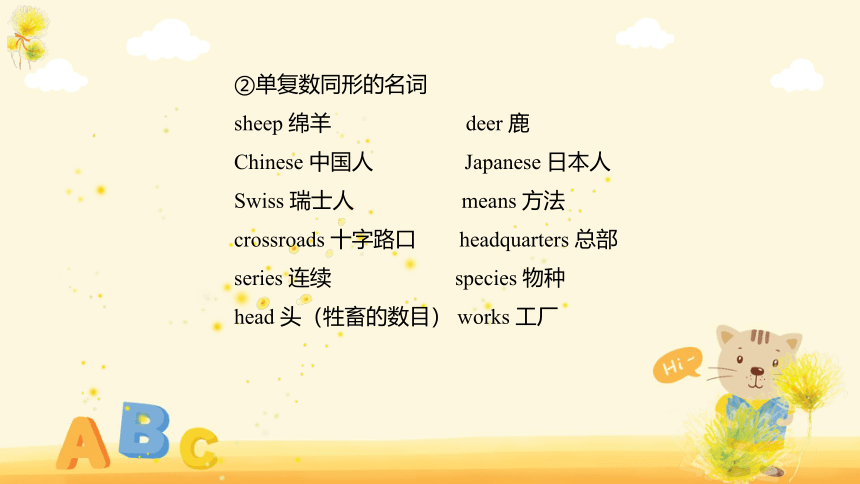
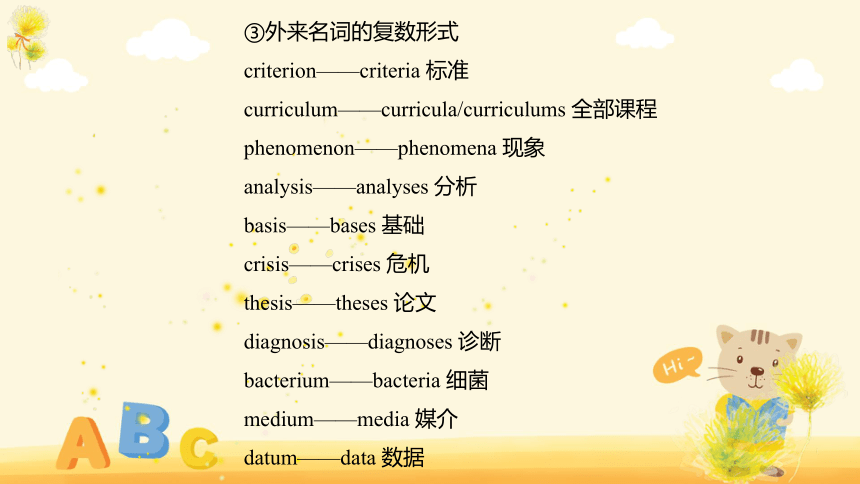
文档简介
(共50张PPT)
专题一 名词和冠词
01
02
名词
冠词
01
PART ONE
名词
ADD TITLE
add your words here,according to your need to draw the text box size
ADD TITLE
add your words here,according to your need to draw the text box size
名词的分类
名词分为专有名词和可数名词。
1.专有名词
人名、地名、机构、团体等。
2.普通名词
(1)个体名词:作为个体而存在的人或物。如:dog。
(2)集体名词:一类人或物的总称。如:family。
(3)物质名词:原材料或一般无一定形状或大小的实物名称。如:wood。
(4)抽象名词:表示动作、状态、品质等抽象概念的名称。如:happiness。
名词的句法功能
1.名词作主语
Mr. Smith was born in Canada.
史密斯先生出生于加拿大。
2.名词作宾语
Johnson is reading a novel in his study.
约翰逊正在他的书房读小说。
3.名词作表语
She is a lovely girl. 她是一个可爱的女孩。
4.名词作补语
Everyone elected him monitor. 每个人都选他当班长。
5.名词作定语
We will have a meeting on Friday evening.
我们要在星期五晚上开会。
6.名词作状语
We will have a meet on Monday. 我们星期一碰头。
7.名词作同位语
Influenza, a common disease, has no cure.
流行性感冒是一种常见病,无特效药。
8.名词作独立成分
Tom, you look tired. 汤姆,你看上去累了。
名词的数
1.可数名词单数变复数规则
(1)规则变化
①一般情况下,在词尾直接加s。
eg: book——books cap——caps
②以s,x,ch,sh结尾的名词,在词尾加es。
eg: glass——glasses box——boxes
watch——watches brush——brushes
③以辅音字母加y结尾的名词,把y改为i,再加es。
eg: story——stories country——countries
④以o结尾的名词变为复数时,一般直接加s。但中学英语中有些名词要加es(一般有生命的物体加es),他们是黑人英雄爱吃土豆和西红柿。
eg:radio——radios photo——photos
Negro——Negroes hero——heroes
potato——potatoes tomato——tomatoes
⑤以f或fe结尾的名词变为复数时,一般直接加s,但有些以f或fe结尾的名词需把f或fe去掉,加ves,它们是:为了自己的牛犊活命,小偷和他的妻子手里拿着刀子和一片树叶站在架子上,把狼劈成两半。
eg: roof——roofs belief——beliefs self——selves calf——calves
life——lives thief——thieves wife——wives knife——knives
leaf——leaves shelf——shelves wolf——wolves half——halves
⑥复合名词变复数时,通常只将里面所含的主体名词变为复数。如果没有主体名词,则将最后一部分变为复数。
son-in-law——sons-in-law storyteller——storytellers
(2)不规则变化
①单复数不同形的名词
foot——feet 脚 man——men 男人
woman——women 女人 mouse——mice 老鼠
tooth——teeth 牙 goose——geese 鹅
child——children 孩子 ox——oxen 公牛
gentleman——gentlemen 绅士
②单复数同形的名词
sheep 绵羊 deer 鹿
Chinese 中国人 Japanese 日本人
Swiss 瑞士人 means 方法
crossroads 十字路口 headquarters 总部
series 连续 species 物种
head 头(牲畜的数目) works 工厂
③外来名词的复数形式
criterion——criteria 标准
curriculum——curricula/curriculums 全部课程
phenomenon——phenomena 现象
analysis——analyses 分析
basis——bases 基础
crisis——crises 危机
thesis——theses 论文
diagnosis——diagnoses 诊断
bacterium——bacteria 细菌
medium——media 媒介
datum——data 数据
(3)作定语的名词的数的变化规则
① man、woman、genleman等作定语,变复数时定语和被修饰的名词都要变复数。
eg: men workers(男工人)、women teachers(女教师)、gentlemen ficials(男性官员)。
②“数词+名词”作定语,表达复数时若有连字符,名词用单数;若无连字符,名词用复数加:“'”。
eg: a ten-mile walk/ten miles' walk(十英里路)
a five-year plan/a five years' plan(一个五年计划)。
③用复数名词作定语:如:sports meeting(运动会),students reading room(学生阅览室),talks table(谈判桌),the foreign languages department(外语系)。
④用单数名词作定语:(名词作定语一般用单数)如:a steel bridge(一座钢桥),paper money(纸币),a coffee cup(一个咖啡杯),an evening paper(一份晚报),city life(城市生活),country music(乡村音乐),office work(办公室工作)street light(路灯)。
2.不可数名词
(1)定义
不可用数目计算的名词是不可数名词。物质名词和抽象名词大多为不可数名词。
(2)汉语中为可数概念而英语中却是不可数名词的词
furniture 家具 equipment 设备 clothing 衣服(总称) news 新闻
information 信息 bread 面包 toothpaste 牙膏 wealth 财富
cloth 布料 poetry 诗歌(总称) machinery 机器(总称) advice 建议
weather 天气 progress 进步 baggage 行李 work 工作
paper 纸 music 音乐
(3)学科名称为不可数名词
eg: maths,politics,physics等
(4)不可数名词量的表示
用“数词/冠词+量词+of+不可数名词”的结构来表示,量词可以是单数也可以是复数,但of后的名词无复数形式。如:
a piece of chalk/jewelry/news/meat/bread/furniture/equipment/luggage/music/
information/thread/advice/clothing/paper
此结构作主语时,谓语的单复数应该跟量词保持一致。
3.有些名词即可作不可数名词又可作可数名词,但意义有所变化。
词条 不可数名词 可数名词
paper 纸张 报纸,论文,试卷
chicken 鸡肉 鸡
hair 头发,毛发 强调几根头发
iron 铁 熨斗
fish 鱼肉 指鱼的条数,单复数同形,为fish;指鱼的种类,复数形式为fishes
room 空间 房间
4.名词前的修饰语
(1)只能修饰可数名词的有each,either,neither,another,these,those,both,(a) few,several,many,a large number of,scores of,dozens of,a great/good many等。
(2)只能修饰不可数名词的有(a) little,much,a bit of,a great deal of,a large amount of等。
(3)既可修饰可数名词又可修饰不可数名词的有some,any,half,most,all,a lot of,lots of,plenty of,a large quantity of,quantities of,masses of等。其中:a large quantity of/quantities of'+可数名词复数/不可数名词作主语时,谓语动词的单复数由quantity 的单复数形式而定。
特别提醒
1.外国计量单位VS中国计量单位
美元,英镑,法郎等都有复数形式,如a dollar,two dollars。
中国传统计量单位大多无复数形式,如yuan(元),jiao(角),jin(斤)
2.不同国籍人的单复数
中国人 the Chinese a Chinese two Chinese
日本人 the Japan a Japanese two Japanese
俄国人 the Russian a Russian two Russians
希腊人 the Greek a Greek two Greeks
法国人 the French a Frenchman two Frenchmen
英国人 the English an Englishman two Englishmen
德国人 the German a German two Germans
瑞典人 the Swedish a Swede two Swedes
名词所有格、名词作定语
1.名词所有格的形式
(1)名词末尾加s。多用于表示有生命的人或动物。
eg: child's play 很容易做的事
(2)介词of加名词。多用于表示无生命的东西。
eg: the top of a house 房顶
2.名词所有格加-'s词尾的规则
(1)单数名词和不以s结尾的复数名词通常在词尾加's。
eg: the boy's bag 那个男孩的包
(2)以s结尾的复数名词,只在词尾加'。
eg: the workers' struggle 工人们的斗争
(3)复合名词中,在最后一个词的词尾加's。
eg: her brother-in-low's character 她丈夫的性格
(4)复合不定代词后加else,在else后加's。
eg: somebody else's possessions 别人的财产
(5)在表示教堂或店铺的名字或某人的家时,名词所有格的后面常常不出现它所修饰的名词。
eg: the barber's 理发店
(6)双重所有格的构成形式:名词+of+名词所有格/名词+of+名词性物主代词
eg: a friend of Leslie's 莱斯利的一个朋友(Leslie's相当于Leslie's friends )
a friend of mine 我(朋友中)的一个朋友(mine相当于my friends)
【注意】
表示各自的所有关系时,名词末尾均加's,如果不是这样,仅在最后一词末尾加's,表示他们共同的所有关系。
如:John's and Mary's schools 约翰和玛丽各自的学校
John and Mary's school 约翰和玛丽的学校
3.名词作定语
作定语的名词说明被修饰的材料、功能、时间、地点、内容、类别等时,用名词而非名词所有格作定语。
材料:a diamond necklace 钻石项链
功能:a meeting room 会议室
时间:Friday night 周五晚上
地点:a table lamp 台灯
内容:piano lessons 钢琴课
类别:adult education 成人教育
4.名词作定语和名词所有格作定语的区别
(1)名词作定语通常说明被修饰的词的性质,而名词所有格作定语则强调与被修饰的词的所属关系或表示逻辑上的主动、被动或同位关系。
eg: the Party members 党员(名词Party表示members的性质)
the Party's calls党的号召(Party具有动作发出者的作用,calls虽然是名词,却具有动作的含义)
(2)名词作定语强调“类指”,而名词所有格则表示“特指”。
eg: Dog food sometimes costs much.
狗食有时很贵。(指类别,即供狗吃的食品)
Please don't put the dog's food under the table.
请不要把狗食放在桌子下面。(特指给某一条狗的食物)
名词常考构词法
后缀 意义 例词
ment 表示“行为、结果” develop—development 发展
achieve—achievement 功绩 equip —equipment 设备
manage—management 管理
agree—agreement 协议,同意,一致
ness 表示“性质、状态或特点” aware—awareness 意识
calm—calmness 平静 lazy—laziness 懒惰
ist 表示“……专家;从事……的人;信仰……的人” art—artist 艺术家
science—scientist 科学家 piano—pianist 钢琴家
ion ation ition tion 表示“行为、状态” attract—attraction 吸引力,吸引
educate—education 教育
invite—invitation 邀请 add—addition 增加
introduce—introduction 介绍
er or ant 表示“……的人” employ—employer 雇主 direct—director 主任,经理
assist—assistant 助手 serve—servant 仆人,职员
an ian 表示“有……特征的人;专长于……的人” history—historian历史学家
music—musician音乐家
ity y 表示“性质、状态” able—ability能力
honest—honesty诚实
ance ence ancy ency 表示“性质、状态或行为” accept—acceptance接受
exist—existence存在
expect—expectancy期待
tend—tendency趋势
age 表示“性质、状态、结果或一组” marry—marriage结婚
short—shortage缺少
pack—package包裹
ship dom 表示“状态、地位” friend—friendship友谊
member—membership会员资格
wise—wisdom智慧
ure 表示“行为或结果” expose—exposure暴露,揭露
fail—failure失败
02
PART TWO
冠词
冠词的泛指、特指
泛指是指首次提到的、不限定的人或事物。
特指是指在上文已提到的人或事物,也可以指说话双方心目中所默认的特定的人或事物。
1.不定冠词的基本用法
不定冠词有a,an两种形式。当冠词后的第一个音素为辅音音素(注意不是辅音字母)时,用a;当冠词后的第一个音素为元音音素(注意不是元音字母)时,用an。
eg: a digital camera,an ant,a university,a one-eyed dog,an hour,an X-ray
不定冠词
(1)hour,honest,honor等词的拼写虽以辅音字母hour开头,但其读音却以元音开头,以此前面要用an。
(2)useful,university,usual,united,European,one-eyed,one-way等单词的拼写虽然以元音字母开头,但其读音却以辅音开头,因此,前面要用a。
(3)如果名词被副词hardly,scarcely,barely,exactly所修饰,或和一个形容词共同修饰时,不定冠词要放在上述副词之后,形容词之前。
eg: This is hardly a right thing to do.
这不是一件正确的事。
特别提醒
2.含不定冠词的常考短语
have a cold 患感冒
have a god time 玩得高兴
have a gift for... 有……的天赋
have a word with... 与……谈话
have/take a rest 休息下
have a holiday 度假
make a living 谋生
get a lift/ride 搭便车
go on a diet 节食
as a result 因此
as a matter of fact 事实上
as a rule 通常,照例
after a while 一会儿后
in a hurry 匆忙
in a sense 在某种意义上
in a word 总之
in a moment 一会儿
once in a while 偶尔
at a loss 困惑,不知所措
at a distance 离……一段距离
for a while 暂时,一会儿
once upon a time 从前
all of a sudden 突然
a waste of… 浪费……
a matter of ... ……问题
have a population... 有……人口
have a history of... 有……的历史
a collection of… 一批……
have a knowledge of(= know) 知道
have an understanding of(= understand) 了解
定冠词
用法:
1.用在表示特指的人或物的名词前。
eg: The book on the desk is mine. 书桌上的那本书是我的。
2.用在姓氏复数前,表示一家人或夫妇二人。
eg: The Chens are going to move to Langfang. 姓陈的一家要搬到廊坊去。
3.用在世纪、年代、朝代名词前或用在表示方位的名词前。
the Tang dynasty 唐朝
the Spring and Autumn Period 春秋时期
in the 1990's/1990s 在20世纪90年代
the south 南方/部
4.用在表度量单位的名词前,表示“每一”。如by the hour/day/week/ month/ year/dozen/yard/ton/kilo,但是size,weight这类名词跟by连用时不加定冠词。
eg: We got paid by the month.
我们按月计酬。
Meat is sold by weight.
肉按重量出售。
5.“the+形容词或分词”有时也可表类指。
eg: the wounded 伤员
the dying 垂死之人
the unknown 未知的事物
the deaf 耳聋的人
6.“动词+sb.+介词+the+身体某部”结构中的the不可用物主代词代替。此外,在be red in the face(脸红),be lame in the right leg(右腿瘸),be blind in the left eye(左眼失明)等结构中,名词前也要用the。
eg: An apple fell from the tree and hit him on the head.
一个苹果从树上落下,砸在了他的头上。
7.用于江河海洋、山脉群岛、海湾海峡等地理名词前。
eg: The Yellow River is the cradle of Chinese culture.
黄河是中华文化的摇篮。
The West Lake is famous for its beautiful scenery.
西湖以其美景著称。
8.用于含普通名词的国家、组织机构、建筑物、报纸杂志、会议条约等名称前。
eg: I shall never forget seeing the Great Wall for the first time.
我永远不会忘记第一次见到长城的情景。
9.用于序数词或形容词、副词的最高级前。注意:当两者进行比较时,在比较级前加定冠词起到特指作用,表示“两者中较……的一方”。
eg: He was the first to speak against slavery.
他是第一个发表演说反对奴隶制的人。
He is the better of the two.
他是两者中较好的那个。
10.用于西方乐器前。
eg: play the piano/violin/guitar弹钢琴/拉小提琴/弹吉他
11.用在same,very,only前构成“the same/very/only +名词”结构。
eg: He is the very person(=just the person)I am looking for.
他正是我在找的人。
He is the only poet in this country that deserves the name.
他是这个国家唯一一位名副其实的诗人。
12.用在某些固定短语中。
in the countryside 在乡下 in the end 最后,终于
in (the) daytime 在白天 in the habit of 习惯于
make the most of 充分利用 in the distance 在远处
in the way 挡路 on the whole 总的说来
on the right/left 在右/左边 at the moment 此刻
for the time being 暂时 in the meantime 同时
at the end of... ……的尽头 in the playground 在操场上
go to the doctor's 去看医生 by the way 顺便提一下
the other day 前几天 on the radio/phone 通过无线电广播/电话
on the spot 在现场,当场,当下 to tell (you) the truth 说实话,老实说
go to the cinema 去看电影
not in the least(=not at all) 一点也不
on the one hand… on the other hand... 一方面……,另一方面……
for the most part 通常,多半 all the time 一直
特别提醒:
1.定冠词通常放在all,both,double,exactly,just等词之后。
2.定冠词要放在half,twice,much之后。
用法:
1.不可数名词,复数名词表泛指用零冠词。
eg: My father went to his doctor for advice about his heart trouble.
我父亲去了他的医生那里寻求关于他的心脏病的建议。
He likes to read novels. 他喜欢读小说。
2.名词前已有this,that,my,your,some,each,no,any等限定词时不再用冠词。
eg: She is not my type of woman. 她不是我心目中的那类女人。
He went to some place in France. 他到法国某地去了。
Each student must hand in his exercise book. 每个学生必须上交他的作业本。
零冠词
3.零冠词的用法口诀:月、季、星期、节假、洲,称呼、头衔、职务前;三餐球类、惯用语;学科、棋类名词前。
但以上用法是相对而言的,在不同的句子中,可能会用到不定冠词或定冠词。因此,用哪种冠词要视情况而定。
eg: A year can be divided into four seasons—spring, summer, autumn and winter.
一年可以分为四个季节——春、夏、秋、冬。
Mr. Li is chairman of the meeting.
李先生是本次会议的主席。
The organization was founded in the spring of (the year) 2010.
这个组织是在2010年的春天成立的。
4.英语中常见的不可数名词有:baggage,luggage,furniture,health, weather,fun,space(太空),advice,progress, information,news,luck,wealth(财产)等。以上不可数名词不能与不定冠词连用。
eg: Beyond the stars, the astronaut saw nothing but space.
除了星星,那个宇航员只看见了太空。
5.系动词turn(变成)后的单数名词作表语用零冠词。
eg: Has he turned scientist 他成为科学家了吗?
6.“零冠词+单数名词+as though+主语+谓语+主句”,意为“虽然/尽管……,但是……”
eg: Hero as he is, he has some shortcomings.
他虽然是英雄,但是也有一些缺点。
7.用在一些固定短语中。
at college 在上大学 at dark 天黑时
at dinner 在吃饭 at home 在家里
at peace 处于和平状态 in addition 另外
in advance 预先 in good condition 情况良好
in good order 有条不紊 lose weight 减肥
on business 因公出差 pay attention to 注意
冠词的活用
1.表示世界上独一无二的事物的名词,如:sun,moon,earth,universe,world 等,常与定冠词连用,但该名词前有形容词修饰时,可以与不定冠词连用。
eg: The moon travels around the earth.
月亮围着地球转。
A bright moon is hanging in the sky.
一轮明月正悬挂在空中。
We have friends all over the world.
我们的朋友遍天下。
We are building a new world.
我们正在建立一个新世界。
2.“the+形容词最高级”表示比较,意为最……的;“a/an+形容词最高级”无比较含义。
eg: It is the most useful dictionary.
它是最有用的词典。
It is a most useful dictionary.(most = very)
它是一本非常有用的词典。
3.“the+序数词”表示次序;“a/an+序数词”不表示与其他人或物排序,而表示“又一,再一”
eg: It is the second time that he has visited the city.
这是他第二次参观这座城市。(表示次序)
Can you give me a second chance (a second=another)
你能再给我一次机会吗?
有无冠词意义迥异的情况
at table 在吃饭 at the table 在桌子旁
at school 上学 at the school 在学校
by day 白天 by the day 按日计算
go to bed 上床睡觉(侧重活动)
go to the bed 朝床边走去(侧重地点)
go to church 做礼拜(侧重活动)
go to the church 去教堂(侧重地点)
in hospital 住院 in the hospital 在医院
in charge of 掌管 in the charge of 由……掌管
in place of 取代 in the place of 在……的位置上
in office 执政 in the office 在办公室内
in possession of 占有 in the possession of 被……占有
leave school 辍学 leave the school 离开学校
out of question 毫无疑问 out of the question 不可能
two of us 我们中的两个 the two of us 我们两个
in front of...(外部)的前面 in the front of...(内部)的前部
Thank you
专题一 名词和冠词
01
02
名词
冠词
01
PART ONE
名词
ADD TITLE
add your words here,according to your need to draw the text box size
ADD TITLE
add your words here,according to your need to draw the text box size
名词的分类
名词分为专有名词和可数名词。
1.专有名词
人名、地名、机构、团体等。
2.普通名词
(1)个体名词:作为个体而存在的人或物。如:dog。
(2)集体名词:一类人或物的总称。如:family。
(3)物质名词:原材料或一般无一定形状或大小的实物名称。如:wood。
(4)抽象名词:表示动作、状态、品质等抽象概念的名称。如:happiness。
名词的句法功能
1.名词作主语
Mr. Smith was born in Canada.
史密斯先生出生于加拿大。
2.名词作宾语
Johnson is reading a novel in his study.
约翰逊正在他的书房读小说。
3.名词作表语
She is a lovely girl. 她是一个可爱的女孩。
4.名词作补语
Everyone elected him monitor. 每个人都选他当班长。
5.名词作定语
We will have a meeting on Friday evening.
我们要在星期五晚上开会。
6.名词作状语
We will have a meet on Monday. 我们星期一碰头。
7.名词作同位语
Influenza, a common disease, has no cure.
流行性感冒是一种常见病,无特效药。
8.名词作独立成分
Tom, you look tired. 汤姆,你看上去累了。
名词的数
1.可数名词单数变复数规则
(1)规则变化
①一般情况下,在词尾直接加s。
eg: book——books cap——caps
②以s,x,ch,sh结尾的名词,在词尾加es。
eg: glass——glasses box——boxes
watch——watches brush——brushes
③以辅音字母加y结尾的名词,把y改为i,再加es。
eg: story——stories country——countries
④以o结尾的名词变为复数时,一般直接加s。但中学英语中有些名词要加es(一般有生命的物体加es),他们是黑人英雄爱吃土豆和西红柿。
eg:radio——radios photo——photos
Negro——Negroes hero——heroes
potato——potatoes tomato——tomatoes
⑤以f或fe结尾的名词变为复数时,一般直接加s,但有些以f或fe结尾的名词需把f或fe去掉,加ves,它们是:为了自己的牛犊活命,小偷和他的妻子手里拿着刀子和一片树叶站在架子上,把狼劈成两半。
eg: roof——roofs belief——beliefs self——selves calf——calves
life——lives thief——thieves wife——wives knife——knives
leaf——leaves shelf——shelves wolf——wolves half——halves
⑥复合名词变复数时,通常只将里面所含的主体名词变为复数。如果没有主体名词,则将最后一部分变为复数。
son-in-law——sons-in-law storyteller——storytellers
(2)不规则变化
①单复数不同形的名词
foot——feet 脚 man——men 男人
woman——women 女人 mouse——mice 老鼠
tooth——teeth 牙 goose——geese 鹅
child——children 孩子 ox——oxen 公牛
gentleman——gentlemen 绅士
②单复数同形的名词
sheep 绵羊 deer 鹿
Chinese 中国人 Japanese 日本人
Swiss 瑞士人 means 方法
crossroads 十字路口 headquarters 总部
series 连续 species 物种
head 头(牲畜的数目) works 工厂
③外来名词的复数形式
criterion——criteria 标准
curriculum——curricula/curriculums 全部课程
phenomenon——phenomena 现象
analysis——analyses 分析
basis——bases 基础
crisis——crises 危机
thesis——theses 论文
diagnosis——diagnoses 诊断
bacterium——bacteria 细菌
medium——media 媒介
datum——data 数据
(3)作定语的名词的数的变化规则
① man、woman、genleman等作定语,变复数时定语和被修饰的名词都要变复数。
eg: men workers(男工人)、women teachers(女教师)、gentlemen ficials(男性官员)。
②“数词+名词”作定语,表达复数时若有连字符,名词用单数;若无连字符,名词用复数加:“'”。
eg: a ten-mile walk/ten miles' walk(十英里路)
a five-year plan/a five years' plan(一个五年计划)。
③用复数名词作定语:如:sports meeting(运动会),students reading room(学生阅览室),talks table(谈判桌),the foreign languages department(外语系)。
④用单数名词作定语:(名词作定语一般用单数)如:a steel bridge(一座钢桥),paper money(纸币),a coffee cup(一个咖啡杯),an evening paper(一份晚报),city life(城市生活),country music(乡村音乐),office work(办公室工作)street light(路灯)。
2.不可数名词
(1)定义
不可用数目计算的名词是不可数名词。物质名词和抽象名词大多为不可数名词。
(2)汉语中为可数概念而英语中却是不可数名词的词
furniture 家具 equipment 设备 clothing 衣服(总称) news 新闻
information 信息 bread 面包 toothpaste 牙膏 wealth 财富
cloth 布料 poetry 诗歌(总称) machinery 机器(总称) advice 建议
weather 天气 progress 进步 baggage 行李 work 工作
paper 纸 music 音乐
(3)学科名称为不可数名词
eg: maths,politics,physics等
(4)不可数名词量的表示
用“数词/冠词+量词+of+不可数名词”的结构来表示,量词可以是单数也可以是复数,但of后的名词无复数形式。如:
a piece of chalk/jewelry/news/meat/bread/furniture/equipment/luggage/music/
information/thread/advice/clothing/paper
此结构作主语时,谓语的单复数应该跟量词保持一致。
3.有些名词即可作不可数名词又可作可数名词,但意义有所变化。
词条 不可数名词 可数名词
paper 纸张 报纸,论文,试卷
chicken 鸡肉 鸡
hair 头发,毛发 强调几根头发
iron 铁 熨斗
fish 鱼肉 指鱼的条数,单复数同形,为fish;指鱼的种类,复数形式为fishes
room 空间 房间
4.名词前的修饰语
(1)只能修饰可数名词的有each,either,neither,another,these,those,both,(a) few,several,many,a large number of,scores of,dozens of,a great/good many等。
(2)只能修饰不可数名词的有(a) little,much,a bit of,a great deal of,a large amount of等。
(3)既可修饰可数名词又可修饰不可数名词的有some,any,half,most,all,a lot of,lots of,plenty of,a large quantity of,quantities of,masses of等。其中:a large quantity of/quantities of'+可数名词复数/不可数名词作主语时,谓语动词的单复数由quantity 的单复数形式而定。
特别提醒
1.外国计量单位VS中国计量单位
美元,英镑,法郎等都有复数形式,如a dollar,two dollars。
中国传统计量单位大多无复数形式,如yuan(元),jiao(角),jin(斤)
2.不同国籍人的单复数
中国人 the Chinese a Chinese two Chinese
日本人 the Japan a Japanese two Japanese
俄国人 the Russian a Russian two Russians
希腊人 the Greek a Greek two Greeks
法国人 the French a Frenchman two Frenchmen
英国人 the English an Englishman two Englishmen
德国人 the German a German two Germans
瑞典人 the Swedish a Swede two Swedes
名词所有格、名词作定语
1.名词所有格的形式
(1)名词末尾加s。多用于表示有生命的人或动物。
eg: child's play 很容易做的事
(2)介词of加名词。多用于表示无生命的东西。
eg: the top of a house 房顶
2.名词所有格加-'s词尾的规则
(1)单数名词和不以s结尾的复数名词通常在词尾加's。
eg: the boy's bag 那个男孩的包
(2)以s结尾的复数名词,只在词尾加'。
eg: the workers' struggle 工人们的斗争
(3)复合名词中,在最后一个词的词尾加's。
eg: her brother-in-low's character 她丈夫的性格
(4)复合不定代词后加else,在else后加's。
eg: somebody else's possessions 别人的财产
(5)在表示教堂或店铺的名字或某人的家时,名词所有格的后面常常不出现它所修饰的名词。
eg: the barber's 理发店
(6)双重所有格的构成形式:名词+of+名词所有格/名词+of+名词性物主代词
eg: a friend of Leslie's 莱斯利的一个朋友(Leslie's相当于Leslie's friends )
a friend of mine 我(朋友中)的一个朋友(mine相当于my friends)
【注意】
表示各自的所有关系时,名词末尾均加's,如果不是这样,仅在最后一词末尾加's,表示他们共同的所有关系。
如:John's and Mary's schools 约翰和玛丽各自的学校
John and Mary's school 约翰和玛丽的学校
3.名词作定语
作定语的名词说明被修饰的材料、功能、时间、地点、内容、类别等时,用名词而非名词所有格作定语。
材料:a diamond necklace 钻石项链
功能:a meeting room 会议室
时间:Friday night 周五晚上
地点:a table lamp 台灯
内容:piano lessons 钢琴课
类别:adult education 成人教育
4.名词作定语和名词所有格作定语的区别
(1)名词作定语通常说明被修饰的词的性质,而名词所有格作定语则强调与被修饰的词的所属关系或表示逻辑上的主动、被动或同位关系。
eg: the Party members 党员(名词Party表示members的性质)
the Party's calls党的号召(Party具有动作发出者的作用,calls虽然是名词,却具有动作的含义)
(2)名词作定语强调“类指”,而名词所有格则表示“特指”。
eg: Dog food sometimes costs much.
狗食有时很贵。(指类别,即供狗吃的食品)
Please don't put the dog's food under the table.
请不要把狗食放在桌子下面。(特指给某一条狗的食物)
名词常考构词法
后缀 意义 例词
ment 表示“行为、结果” develop—development 发展
achieve—achievement 功绩 equip —equipment 设备
manage—management 管理
agree—agreement 协议,同意,一致
ness 表示“性质、状态或特点” aware—awareness 意识
calm—calmness 平静 lazy—laziness 懒惰
ist 表示“……专家;从事……的人;信仰……的人” art—artist 艺术家
science—scientist 科学家 piano—pianist 钢琴家
ion ation ition tion 表示“行为、状态” attract—attraction 吸引力,吸引
educate—education 教育
invite—invitation 邀请 add—addition 增加
introduce—introduction 介绍
er or ant 表示“……的人” employ—employer 雇主 direct—director 主任,经理
assist—assistant 助手 serve—servant 仆人,职员
an ian 表示“有……特征的人;专长于……的人” history—historian历史学家
music—musician音乐家
ity y 表示“性质、状态” able—ability能力
honest—honesty诚实
ance ence ancy ency 表示“性质、状态或行为” accept—acceptance接受
exist—existence存在
expect—expectancy期待
tend—tendency趋势
age 表示“性质、状态、结果或一组” marry—marriage结婚
short—shortage缺少
pack—package包裹
ship dom 表示“状态、地位” friend—friendship友谊
member—membership会员资格
wise—wisdom智慧
ure 表示“行为或结果” expose—exposure暴露,揭露
fail—failure失败
02
PART TWO
冠词
冠词的泛指、特指
泛指是指首次提到的、不限定的人或事物。
特指是指在上文已提到的人或事物,也可以指说话双方心目中所默认的特定的人或事物。
1.不定冠词的基本用法
不定冠词有a,an两种形式。当冠词后的第一个音素为辅音音素(注意不是辅音字母)时,用a;当冠词后的第一个音素为元音音素(注意不是元音字母)时,用an。
eg: a digital camera,an ant,a university,a one-eyed dog,an hour,an X-ray
不定冠词
(1)hour,honest,honor等词的拼写虽以辅音字母hour开头,但其读音却以元音开头,以此前面要用an。
(2)useful,university,usual,united,European,one-eyed,one-way等单词的拼写虽然以元音字母开头,但其读音却以辅音开头,因此,前面要用a。
(3)如果名词被副词hardly,scarcely,barely,exactly所修饰,或和一个形容词共同修饰时,不定冠词要放在上述副词之后,形容词之前。
eg: This is hardly a right thing to do.
这不是一件正确的事。
特别提醒
2.含不定冠词的常考短语
have a cold 患感冒
have a god time 玩得高兴
have a gift for... 有……的天赋
have a word with... 与……谈话
have/take a rest 休息下
have a holiday 度假
make a living 谋生
get a lift/ride 搭便车
go on a diet 节食
as a result 因此
as a matter of fact 事实上
as a rule 通常,照例
after a while 一会儿后
in a hurry 匆忙
in a sense 在某种意义上
in a word 总之
in a moment 一会儿
once in a while 偶尔
at a loss 困惑,不知所措
at a distance 离……一段距离
for a while 暂时,一会儿
once upon a time 从前
all of a sudden 突然
a waste of… 浪费……
a matter of ... ……问题
have a population... 有……人口
have a history of... 有……的历史
a collection of… 一批……
have a knowledge of(= know) 知道
have an understanding of(= understand) 了解
定冠词
用法:
1.用在表示特指的人或物的名词前。
eg: The book on the desk is mine. 书桌上的那本书是我的。
2.用在姓氏复数前,表示一家人或夫妇二人。
eg: The Chens are going to move to Langfang. 姓陈的一家要搬到廊坊去。
3.用在世纪、年代、朝代名词前或用在表示方位的名词前。
the Tang dynasty 唐朝
the Spring and Autumn Period 春秋时期
in the 1990's/1990s 在20世纪90年代
the south 南方/部
4.用在表度量单位的名词前,表示“每一”。如by the hour/day/week/ month/ year/dozen/yard/ton/kilo,但是size,weight这类名词跟by连用时不加定冠词。
eg: We got paid by the month.
我们按月计酬。
Meat is sold by weight.
肉按重量出售。
5.“the+形容词或分词”有时也可表类指。
eg: the wounded 伤员
the dying 垂死之人
the unknown 未知的事物
the deaf 耳聋的人
6.“动词+sb.+介词+the+身体某部”结构中的the不可用物主代词代替。此外,在be red in the face(脸红),be lame in the right leg(右腿瘸),be blind in the left eye(左眼失明)等结构中,名词前也要用the。
eg: An apple fell from the tree and hit him on the head.
一个苹果从树上落下,砸在了他的头上。
7.用于江河海洋、山脉群岛、海湾海峡等地理名词前。
eg: The Yellow River is the cradle of Chinese culture.
黄河是中华文化的摇篮。
The West Lake is famous for its beautiful scenery.
西湖以其美景著称。
8.用于含普通名词的国家、组织机构、建筑物、报纸杂志、会议条约等名称前。
eg: I shall never forget seeing the Great Wall for the first time.
我永远不会忘记第一次见到长城的情景。
9.用于序数词或形容词、副词的最高级前。注意:当两者进行比较时,在比较级前加定冠词起到特指作用,表示“两者中较……的一方”。
eg: He was the first to speak against slavery.
他是第一个发表演说反对奴隶制的人。
He is the better of the two.
他是两者中较好的那个。
10.用于西方乐器前。
eg: play the piano/violin/guitar弹钢琴/拉小提琴/弹吉他
11.用在same,very,only前构成“the same/very/only +名词”结构。
eg: He is the very person(=just the person)I am looking for.
他正是我在找的人。
He is the only poet in this country that deserves the name.
他是这个国家唯一一位名副其实的诗人。
12.用在某些固定短语中。
in the countryside 在乡下 in the end 最后,终于
in (the) daytime 在白天 in the habit of 习惯于
make the most of 充分利用 in the distance 在远处
in the way 挡路 on the whole 总的说来
on the right/left 在右/左边 at the moment 此刻
for the time being 暂时 in the meantime 同时
at the end of... ……的尽头 in the playground 在操场上
go to the doctor's 去看医生 by the way 顺便提一下
the other day 前几天 on the radio/phone 通过无线电广播/电话
on the spot 在现场,当场,当下 to tell (you) the truth 说实话,老实说
go to the cinema 去看电影
not in the least(=not at all) 一点也不
on the one hand… on the other hand... 一方面……,另一方面……
for the most part 通常,多半 all the time 一直
特别提醒:
1.定冠词通常放在all,both,double,exactly,just等词之后。
2.定冠词要放在half,twice,much之后。
用法:
1.不可数名词,复数名词表泛指用零冠词。
eg: My father went to his doctor for advice about his heart trouble.
我父亲去了他的医生那里寻求关于他的心脏病的建议。
He likes to read novels. 他喜欢读小说。
2.名词前已有this,that,my,your,some,each,no,any等限定词时不再用冠词。
eg: She is not my type of woman. 她不是我心目中的那类女人。
He went to some place in France. 他到法国某地去了。
Each student must hand in his exercise book. 每个学生必须上交他的作业本。
零冠词
3.零冠词的用法口诀:月、季、星期、节假、洲,称呼、头衔、职务前;三餐球类、惯用语;学科、棋类名词前。
但以上用法是相对而言的,在不同的句子中,可能会用到不定冠词或定冠词。因此,用哪种冠词要视情况而定。
eg: A year can be divided into four seasons—spring, summer, autumn and winter.
一年可以分为四个季节——春、夏、秋、冬。
Mr. Li is chairman of the meeting.
李先生是本次会议的主席。
The organization was founded in the spring of (the year) 2010.
这个组织是在2010年的春天成立的。
4.英语中常见的不可数名词有:baggage,luggage,furniture,health, weather,fun,space(太空),advice,progress, information,news,luck,wealth(财产)等。以上不可数名词不能与不定冠词连用。
eg: Beyond the stars, the astronaut saw nothing but space.
除了星星,那个宇航员只看见了太空。
5.系动词turn(变成)后的单数名词作表语用零冠词。
eg: Has he turned scientist 他成为科学家了吗?
6.“零冠词+单数名词+as though+主语+谓语+主句”,意为“虽然/尽管……,但是……”
eg: Hero as he is, he has some shortcomings.
他虽然是英雄,但是也有一些缺点。
7.用在一些固定短语中。
at college 在上大学 at dark 天黑时
at dinner 在吃饭 at home 在家里
at peace 处于和平状态 in addition 另外
in advance 预先 in good condition 情况良好
in good order 有条不紊 lose weight 减肥
on business 因公出差 pay attention to 注意
冠词的活用
1.表示世界上独一无二的事物的名词,如:sun,moon,earth,universe,world 等,常与定冠词连用,但该名词前有形容词修饰时,可以与不定冠词连用。
eg: The moon travels around the earth.
月亮围着地球转。
A bright moon is hanging in the sky.
一轮明月正悬挂在空中。
We have friends all over the world.
我们的朋友遍天下。
We are building a new world.
我们正在建立一个新世界。
2.“the+形容词最高级”表示比较,意为最……的;“a/an+形容词最高级”无比较含义。
eg: It is the most useful dictionary.
它是最有用的词典。
It is a most useful dictionary.(most = very)
它是一本非常有用的词典。
3.“the+序数词”表示次序;“a/an+序数词”不表示与其他人或物排序,而表示“又一,再一”
eg: It is the second time that he has visited the city.
这是他第二次参观这座城市。(表示次序)
Can you give me a second chance (a second=another)
你能再给我一次机会吗?
有无冠词意义迥异的情况
at table 在吃饭 at the table 在桌子旁
at school 上学 at the school 在学校
by day 白天 by the day 按日计算
go to bed 上床睡觉(侧重活动)
go to the bed 朝床边走去(侧重地点)
go to church 做礼拜(侧重活动)
go to the church 去教堂(侧重地点)
in hospital 住院 in the hospital 在医院
in charge of 掌管 in the charge of 由……掌管
in place of 取代 in the place of 在……的位置上
in office 执政 in the office 在办公室内
in possession of 占有 in the possession of 被……占有
leave school 辍学 leave the school 离开学校
out of question 毫无疑问 out of the question 不可能
two of us 我们中的两个 the two of us 我们两个
in front of...(外部)的前面 in the front of...(内部)的前部
Thank you
